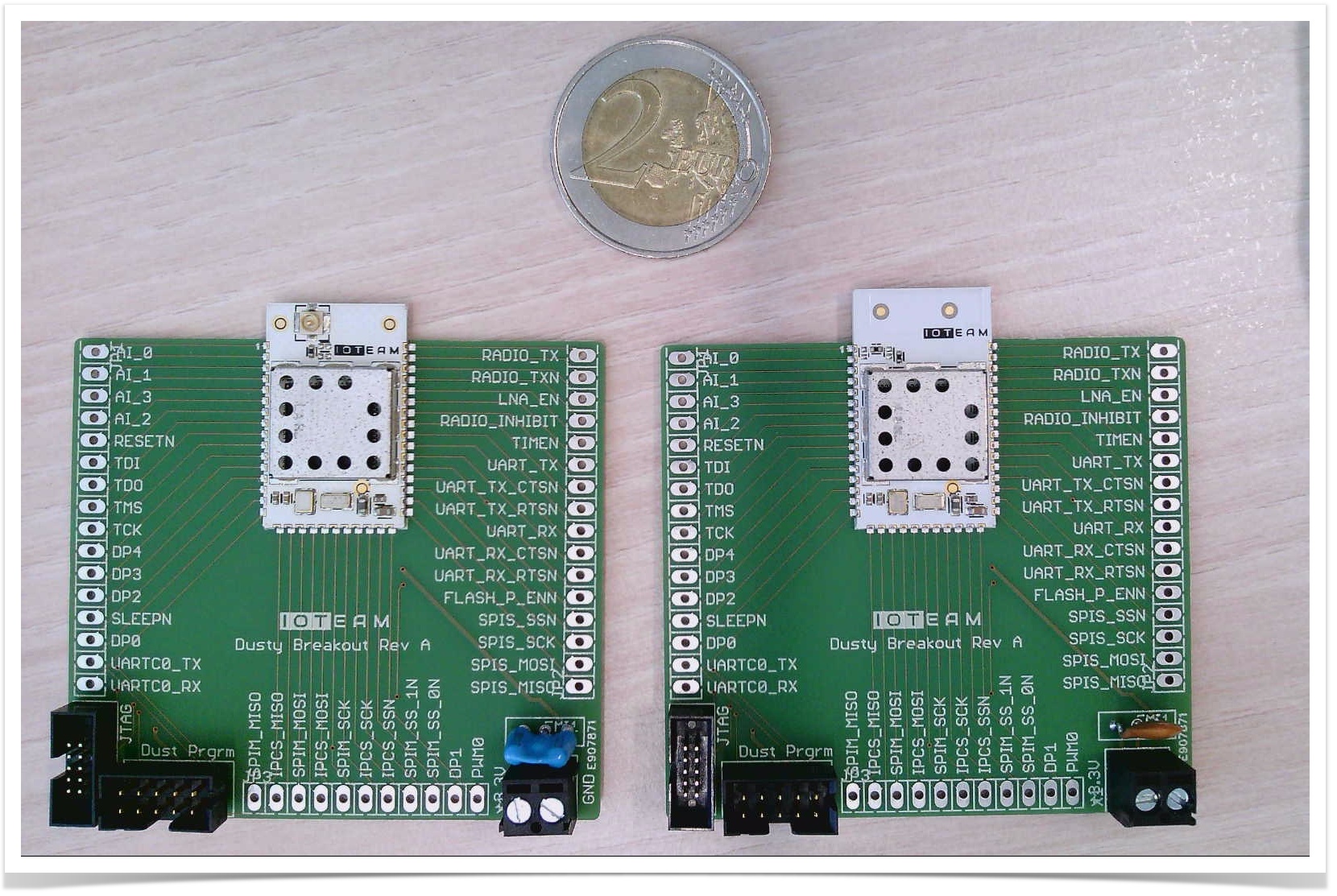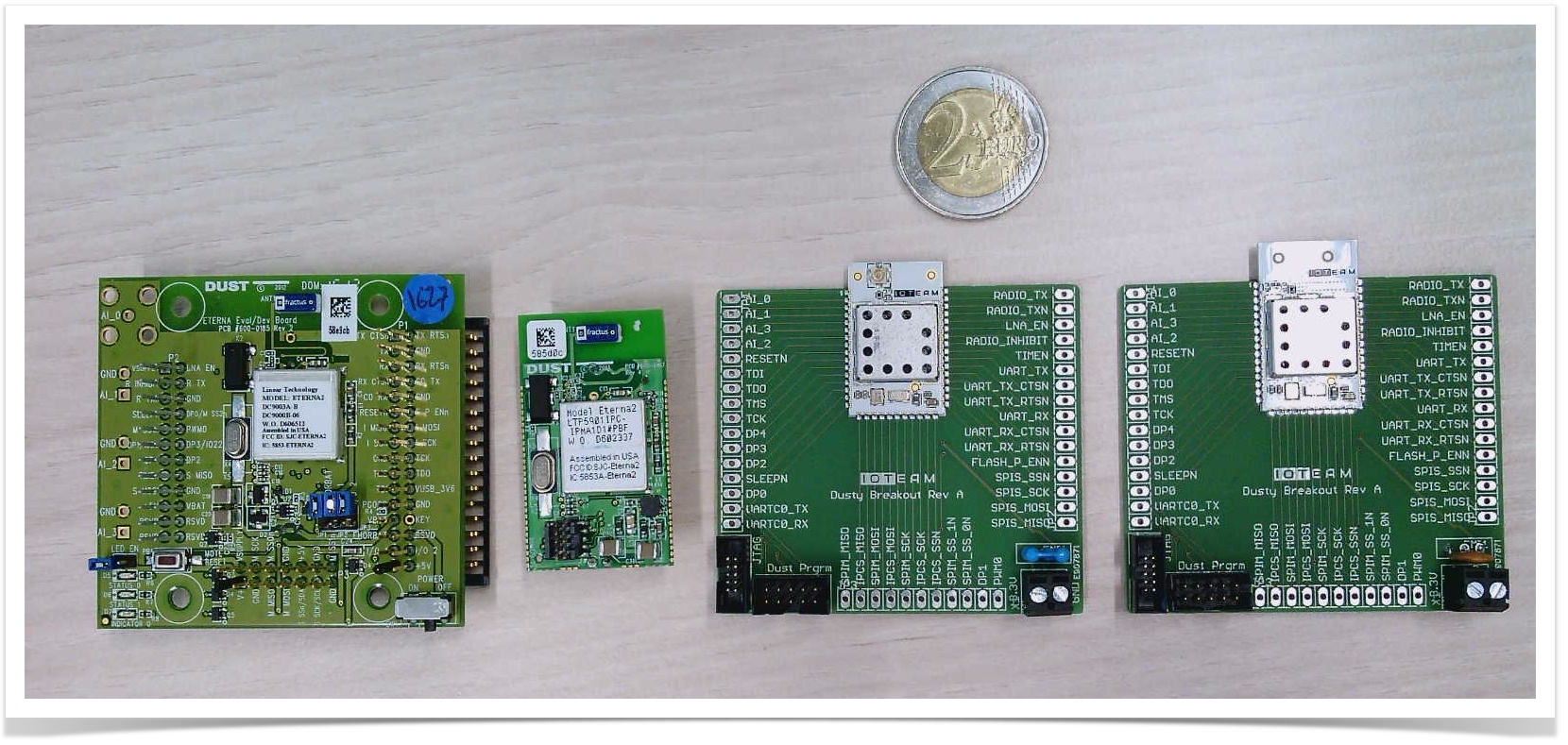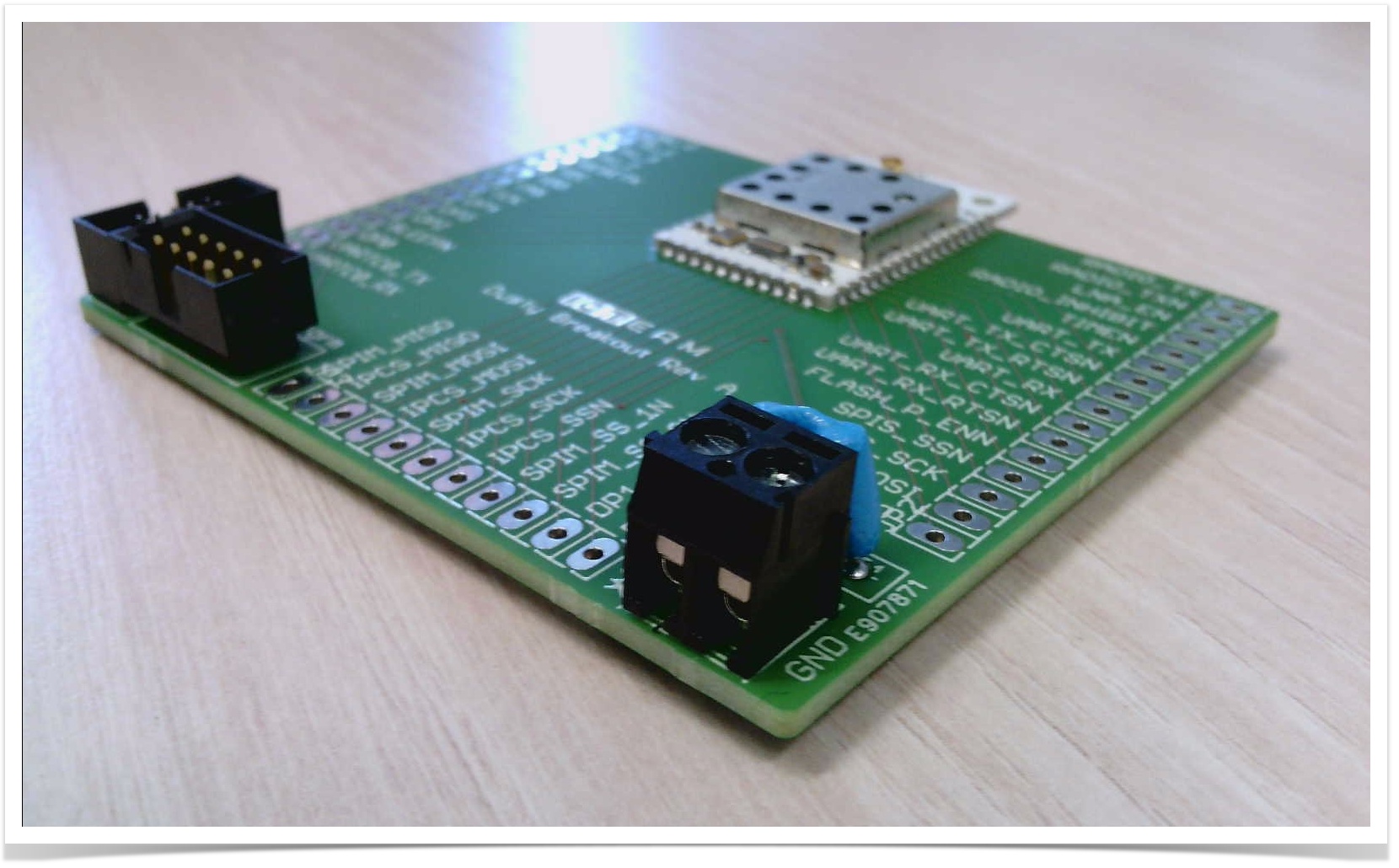We show you how to get started with your IOTEAM Dusty motes and managers!
|
|
Dusty is a fully SmartMesh IP capable module commercialized by IOTEAM (http://ioteam.strikingly.com).
IOTEAM sells two versions of the Dusty:
While you can buy just the module, for testing and prototyping, IOTEAM can ship you the module mounted on a breakout board, as shown below.

The Dusty is smaller than the motes and modules manufactured by Analog Devices:
 In the picture above, from left to right:
In the picture above, from left to right:
The Dusty mote features exactly the same LTC5800 chip, and is functionally identical to the LTP5901. This means that the Dusty mote, although it has a smaller footprint, behaves exactly the same. It is possible to build networks with a combination of Dusty and non-Dusty SmartMesh IP devices. |
Any Dusty module can be programmed either as a manager or a mote. The modules come pre-programmed as either mote or manager according to your order, but you can easily reprogram them. |
The Dusty breakout board comes with a very handy connector with 2 screw terminals, ideal for connecting a battery pack or any 3.3V external power source.

Just connecting the battery pack is enough to power the mote, no need to switch anything else on or off. |
The Dusty breakout comes with the standard 10-pin Dust programming header ("Dust Prgrm" on the silkscreen).

This allows you to use the standard Dust interface boards and programmers to connect to Dusty:
|
|
| DC9010B Eterna Serial Programmer | using a DC9006A+DC9904A combo |
|---|
Both options depicted above are equivalent. |
Through the programmer or the interface card, you are able to:
By default, the mote is in slave mode. If you want the mote to join a manager automatically (i.e. without using an external micro-controller), you can switch it to "master" mode:
> set mode master > reset |
During this step, I use a DC2274 board as a manager, to verify the Dusty mote connects to it.
|
After the mote has reset, you can see it joining the manager:
> SmartMesh IP mote, ver 1.3.3.1 (0x40100) 5010 : Joining 5355 : Connected 11745 : Active |
At the time of writing, the Dusty ships with IP mote 1.3.3.1 firmware:
> info IP Mote: 1.3.3.1 Join state: Complete Bandwidth Allocated: 8418 Serial mode: n/a Serial Baud Rate: n/a Radio Test: off |
You can see the mote's (unique) MAC address by typing the following command:
> minfo Net stack v1.2.4.1 state: Oper mac: 00:17:0d:00:00:59:53:7a moteid: 2 netid: 1229 blSwVer: 15 ldrSwVer: 1.0.3.12 UTC time: 1025665345:237318 reset st: 40100 |
On the manager side, you can see that the mote has joined:
> login user
> sm
MAC MoteId State Nbrs Links Joins Age StateTime
00-17-0D-00-00-30-5D-39 1 Oper 1 21 1 0 0-00:00:32
00-17-0D-00-00-59-53-7A 2 Oper 1 9 1 6 0-00:00:10
Number of motes (max 101): Total 2, Live 2, Joining 0 |
You can ping your mote from the manager:
> ping 2 Sending ping request to mote 2 > Ping response from mote 2, time=1495 msec v=3062 t=26 |
The difference between a manager and a mote is just the firmware. Their hardware is otherwise entirely equivalent. In particular, you power and connect to the board the same way. |
At the time of writing, the Dusty comes with manager firmware version 1.2.4.1.
> login user > show ver SmartMesh IP Manager ver 1.2.4.1. |
Because the Dusty breakout does not come with external memory, you can connect at most 32 motes to it (the "maxmotes" field below includes 32 motes and 1 manager).
The pins to connect external memory are present on the Dusty, so it's possible to build a board with a Dusty and external memory to be able to handle up to 100 motes. |
> show config netid = 1229 txpower = 8 frprofile = 1 maxmotes = 33 basebw = 9000 dnfr_mult = 1 numparents = 2 cca = 0 channellist = 00:00:7f:ff autostart = 1 locmode = 0 bbmode = 0 bbsize = 1 license = 00:00:00:00:00:00:00:00:00:00:00:00:00 ip6prefix = fe:80:00:00:00:00:00:00:00:00:00:00:00:00:00:00 ip6mask = ff:ff:ff:ff:ff:ff:ff:ff:00:00:00:00:00:00:00:00 radiotest = 0 bwmult = 300 onechannel = 255 |
I have 13 additional non-Dusty SmartMesh IP motes running in master mode for the following step. |
You can see that 13 motes, with MoteIds 2 through 14, have joined the manager (MoteId 1):
> sm
MAC MoteId State Nbrs Links Joins Age StateTime
00-17-0D-00-00-59-54-44 1 Oper 12 33 1 0 0-00:38:28
00-17-0D-00-00-38-03-D9 2 Oper 4 13 1 7 0-00:37:40
00-17-0D-00-00-38-03-87 3 Oper 3 11 1 3 0-00:23:47
00-17-0D-00-00-38-05-E9 4 Oper 4 12 1 16 0-00:20:28
00-17-0D-00-00-38-06-67 5 Oper 4 12 1 23 0-00:18:57
00-17-0D-00-00-38-07-18 6 Oper 3 11 1 1 0-00:18:08
00-17-0D-00-00-38-07-0C 7 Oper 2 10 1 28 0-00:11:57
00-17-0D-00-00-38-04-25 8 Oper 2 10 1 25 0-00:04:59
00-17-0D-00-00-38-06-6A 9 Oper 4 12 1 22 0-00:07:32
00-17-0D-00-00-38-06-D6 10 Oper 3 11 1 22 0-00:04:48
00-17-0D-00-00-38-05-F1 11 Oper 2 10 1 29 0-00:03:41
00-17-0D-00-00-38-03-69 12 Oper 3 11 1 2 0-00:04:47
00-17-0D-00-00-38-06-45 13 Oper 2 10 1 1 0-00:03:35
00-17-0D-00-00-38-00-63 14 Oper 2 9 1 27 0-00:03:08
Number of motes (max 33): Total 14, Live 14, Joining 0 |